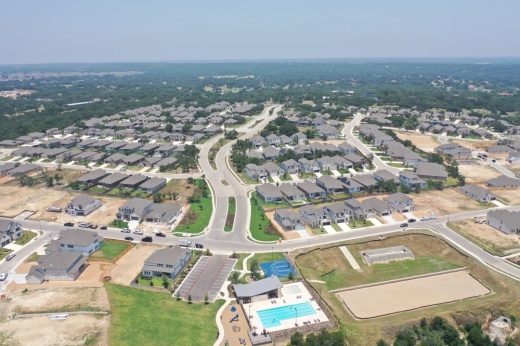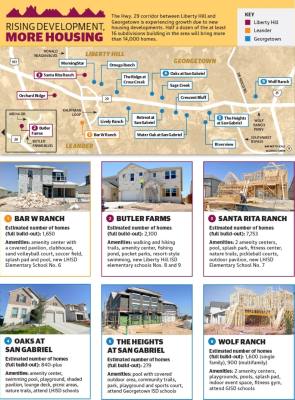The stretch of road encompasses three school districts and includes Santa Rita Ranch, one of the largest neighborhoods, which could bring 7,753 homes to the area once fully built out. Other sizable subdivisions are under construction or planned.
New residents are attributing their moves to the northern suburbs to increasing home prices in Austin; the busyness of Austin; and the developmental potential for Leander, Georgetown and Liberty Hill.
The increased number of housing developments along Hwy. 29 has led to mixed reactions from residents and left officials looking at how the needs of existing residents can be balanced with the demand for infrastructure. Georgetown Assistant City Manager Nick Woolery said planning for the stretch of road requires coordination among multiple cities, Williamson County, the Texas Department of Transportation and numerous housing developers.
“The area that you’re talking about is challenging because it covers three different cities,” Woolery said. “So we’ve got Georgetown, Leander and Liberty Hill, and in between there, a lot of that development is not within one of those three city limits.”
More residents, more neighborhoods
Logan Cheney said he made the move from Austin to Santa Rita Ranch in Liberty Hill because Austin became too busy and loud for him.
Cheney said since he moved in a year and a half ago, the area has “blown up.”
Crossing three quickly growing cities, Hwy. 29 has attracted residential developers in the past several years due to the increase of commercial development and continued population growth in the area, officials said.
Developers also look at employment opportunities and nearby amenities, said Rick Hanna, director of land development for Blackburn Homes. He said the organization researches the surrounding market to better understand the area’s demand and price point to fine tune a development’s final design.
Blackburn is in the midst of the first of three phases of The Heights at San Gabriel in Georgetown, which will eventually include 279 homes.
“Georgetown is kind of the next area,” Hanna said. “They’re the fastest-growing city in the country right now, and it’s a great place to raise a family. It just makes sense that you’re going to see development fill in as the metro area grows.”
With Leander ranked as the fourth fastest-growing city with a population of more than 50,000 by the U.S. Census Bureau in 2022 and Liberty Hill’s population growing by 34% year over year, developers are flocking to these cities, too.
“It’s in the path of growth for Austin. Liberty Hill has a great [district] and a great community, and we just felt they’re right in the middle of the path of growth,” said Wyatt Henderson, principal at MA Partners, which is developing Butler Farms.
Butler Farms, a new and growing subdivision in Liberty Hill, is expected to have an estimated 2,100 homes once fully built out. Other subdivisions under construction off or near Hwy. 29 include Santa Rita Ranch, which could have a maximum of 7,753 homes; MorningStar with 1,341; Orchard Ridge with 670; and Bar W Ranch with 1,650. These neighborhoods are just a portion of the homes coming to the region.
According to officials, it’s likely to impact existing infrastructure and warrant the need for more.
“There are other master-planned communities that are enormous. ... That’s all along Hwy. 29, and that’s a lot of people,” Butler Farms resident Antonia Adebo said. “If they don’t move fast—and it doesn’t look like they’re moving fast enough—that could be a problem.”
Building up infrastructure
The influx of new housing is contributing to the rapid rise in population, resulting in increased traffic congestion on Hwy. 29, city officials said. It also has them eyeing utility and support services.
Many residents who live in subdivisions along Hwy. 29, whether in Georgetown or Liberty Hill or in between, told Community Impact they all have the same struggle when it comes to entering or leaving their neighborhoods: it’s overwhelmingly dangerous and difficult.
Melissa Matias, a seven-year resident of Oaks at San Gabriel, said “it’s like playing ‘Frogger’” every time she pulls out onto the road.
“We knew it was going to grow at some point,” Matias said. “I guess we just weren’t prepared for how fast. I feel like the changes that need to be made to keep up with the growth, especially when you’re talking about [Hwy.] 29, are just not happening fast enough.”
As a result, TxDOT, Liberty Hill, Leander, Georgetown, Williamson County and developers have all coordinated to improve safety for drivers on Hwy. 29.
“To bear the improvements that would be necessary to support the type of volumes, really any one city would have difficulty doing that,” Leander City Manager Rick Beverlin said.
Several road projects are now underway or recently finished, including preventive maintenance by TxDOT, a road widening project near the Wolf Ranch development, alternative routes for motorists to reach I-35, intersection improvements to make turning on and off the road easier, and traffic lights to slow vehicles down.
In the same way officials are planning transportation projects, both developers and governments are trying to address water infrastructure.
For example, Hanna said Blackburn is building the connections to nearby city of Georgetown water and sewer access.
Georgetown provides water even outside of its extraterritorial jurisdiction. It’s in the process of constructing the South Lake Water Treatment Plant—a $175.3 million project that will produce 44 million gallons of treated water a day. Woolery called it the largest capital project the city’s ever done.
In Leander and Liberty Hill, officials are also teaming up with developers.
Henderson said MA Partners spent tens of millions of dollars to bring water from Liberty Hill’s water plant to Butler Farms.
While officials said they believe more work is needed to address the growth of the area, Liberty Hill Director of Planning Jerry Millard said the timing is important.
“The amount of development we see is driving those projects, so we just don’t want a bunch of infrastructure sitting in the ground if it’s not going to be used,” he said.







